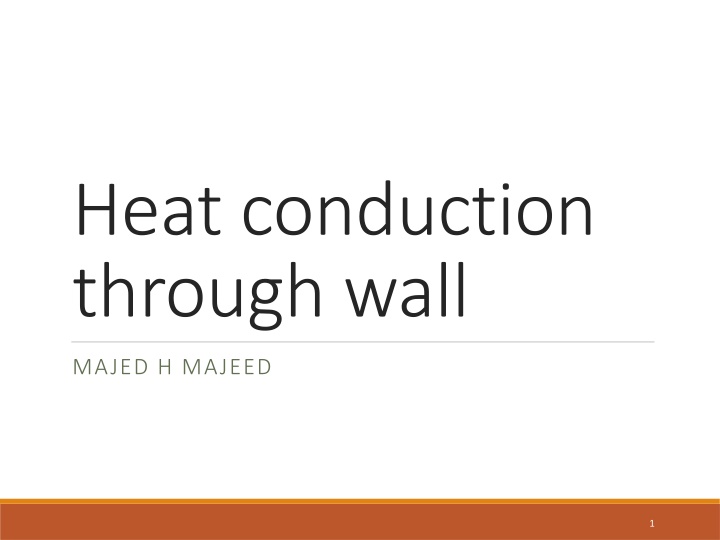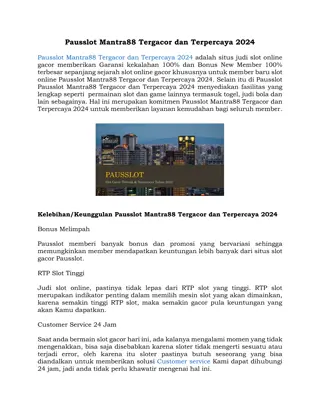
Heat Conduction in Walls
Explore the principles of heat conduction in walls, including Fourier's equation, heat flux, thermal resistance, and overall heat transfer coefficients. Learn through examples on calculating heat transfer and temperature gradients.
Download Presentation

Please find below an Image/Link to download the presentation.
The content on the website is provided AS IS for your information and personal use only. It may not be sold, licensed, or shared on other websites without obtaining consent from the author. If you encounter any issues during the download, it is possible that the publisher has removed the file from their server.
You are allowed to download the files provided on this website for personal or commercial use, subject to the condition that they are used lawfully. All files are the property of their respective owners.
The content on the website is provided AS IS for your information and personal use only. It may not be sold, licensed, or shared on other websites without obtaining consent from the author.
E N D
Presentation Transcript
Heat conduction through wall MAJED H MAJEED 1
Heat conduction in the wall Heat conduction through Plane wall Fourier Equation is ? = ???1 ?2 ? The heat flux ? =? ?= ??1 ?2 ? 2
Heat Conduction in a wall ? =?1 ?2 =?1 ?2 ?? ? ?? ?? = ? ?? ?????????? ?????????? ? = ? ?? ? ? =?? ? 1 ? ?? ? ????? = 1 ?????= ? 3
Conduction in a wall Radiation and convection combination. ? = ?????+ ???? ? = ? ?????? ? + ? ????? ? ? = ? ????+ ???? ?? ? ? = ? ?????? ? ????= ????+ ??? 4
Conduction in a wall The over all heat transfer coefficient is U 1 1 ?? = ?????? ? = ??????? 7
examples Example.1. Determine the heat transfer across a plane wall of (20cm) thickness and a constant thermal conductivity of (10W/m.K). The temperatures of surface are steady at (120?C) and (20?). The area of the wall is (2?2). Also determine the temperature gradient in the direction of flow and the temperature at the midpoint of the wall. 9
Examples Solution: heat transfer by conduction through the wall of thickness x=20cm=0.2m and area A=2?2. The surface temperatures are (?1=120?C) and (?2=20?C) Property: constant thermal conductivity, k=10W/m.K Assumption: Steady-state and one dimensional heat conduction Analysis: The heat transfer through the wall can be determined by Fourier's law of conduction. 10
Examples 11
Examples Example 2. The temperature of gases in a furnace is (500K). The temperature of inside surface of the furnace is (400K). The heat transfer between the gases and the surface of the furnace occurs by convection and radiation. The convection coefficient is (20W/?2.??). The furnace surface emissivity is (0.9). Find the combined heat transfer coefficient and the heat transfer rate per unit area. 12
Examples Solution: heat transfer by convection and radiation between furnace surface and the hot gases ??=400K, and ? =500K Property: constant property h=20W/?2.?? and =0.9 Assumption: steady-state radiation and convection Analysis: the heat transfer coefficient of radiation can be determined by 13
Examples: 14
Examples Example 3 A wall of thickness (3cm) and thermal conductivity of (24W/?.?C). The wall is exposed to heat transfer by convection on both sides. The temperature and coefficient of heat transfer on the inner face are ( 100?C) and (10W/ ?2.?C) respectively. The temperature and coefficient of heat transfer on the other surface are (25?C) and (20W/?2?C) respectively. If the wall area is (4?2), find the heat transfer rate. Determine the temperatures at the two sides of the wall. 15
Examples 16
Examples 17
Examples Examples Example 4. A multilayer wall is made of three layers. Layer (1) is of thickness (4cm) with thermal conductivity of (24W/?.?C). Layer (2) is of thickness (6cm) with thermal conductivity of (12W/?.?C). Layer (3) is of thickness (2cm) and thermal conductivity (0.8W/?.?C). The layer (1) and layer (3) are exposed to convection heat transfer at the outer faces. The temperatures and heat transfer coefficients are (120?C) and (20W/?2??) and (10?C) and (60W/?2??). Determine the heat transfer through the wall for area of 4.5?2, the two sides temperatures and the interface temperatures. 18
Examples Solution: multilayer plane wall consists of three layers with ?1=4cm, ?1=24W/?.?C, ?2=6cm, k2=12W/?2?C, ?3=2cm k=0.8W/?2?C, 1=20W/?2??, 2=60W/?2?C, ? 1=120?C, T 2=10oC, A=4.5?2 Property: Constant thermal conductivities Assumption: Steady state heat transfer by conduction through a plane wall Analysis: firstly we calculate the thermal resistance of every layer and convection resistance on the two sides: 19
Examples 20
Examples 21
Examples Example5 Consider a (1m) high and (1.5m) wide double glassing window consisting of two ( thick layers (6mm) of glass (k=0.8W/?.?C) separated by a stagnant air space (k=0.025W/??C) of (8mm) wide. Determine the steady rate of heat transfer through this double-pane window and the temperature of its inner surfaces for a day during which the room is maintained at (25?C) while the temperature of the outdoor is (45?C). Take the convection heat transfer coefficients on the inner and outer surfaces of the window to be (10W/?2??) and (40W/?2??) which include the effects of radiation. 22
Examples Solution: a double pane window of two glass layers separated by stagnant air space, L=1m, w= 1.5m, glass layer ??=6mm, ??=0.8W/?.?C, stagnant air ??=8mm, ??=0.025W/?.?C, ??=25?C, ??=45?C, ?=10W/?2.??, ?=40W/?2.??. Property: constant property for air and glass Assumption: steady state heat transfer and one- dimensional Analysis: There are five resistance as shown in Fig. We determine these thermal resistance. The area of the window A=Lxw=1.5x 1=1.5?2. 23
Examples 24
Conduction in a wall Thermal Resistance Networks in Parallel. The concept of thermal resistance or the electric analogy is used to solve problems of heat transfer that involved multilayer or combined parallel and series arrangement. Such problems are often two or three dimensional, but the solution is approximated by assuming the heat transfer in one-dimension using the thermal resistance networks. 25
Conduction in a wall Example 6 A wall of (3m)high and (4m) wide consists a long (16cmx22cm)cross- section horizontal bricks of thermal conductivity (0.72W/?.?C), separated by (3cm) thick plaster layer of thermal conductivity (0.21W/?.?C). There are (2.5cm) thick plasters on the brick on each of its sides and (3cm) of rigid foam with (0.026W/?.?C) on the inner wall side as shown in Figure. 3. The temperatures at indoor and outdoor are (22?C) and (47?C), and the coefficients of convection heat transfer on inner and outer sides are (12W/?2.??) and (42W/?2.??). Determine heat transfer rate through the wall neglecting radiation by assuming it one-dimensional heat transfer . thermal conductivity 28
Conduction in a wall Solution: a wall of brick of cross-section area of (16cmx22cm)with a layer of plaster on each side and rigid foam layer on the inner side the wall is exposed to convection heat transfer on the two sides. From Figure. we can determine the thermal resistance for each component in this composite wall. Property: constant thermal conductivity Assumption: steady state one- dimensional heat transfer, and no effect of radiation Analysis: firstly we calculate the resistance of a pattern as shown in the Figure. 29






















